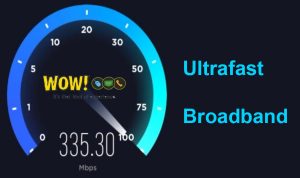A recent analysis of home broadband performance in the UK shows that households with ultrafast broadband connections—defined as having average download speeds over 300Mbps—experience a noticeably better and more consistent internet service compared to those using superfast connections, which offer speeds between 30Mbps and 300Mbps.

The findings are based on data from Opensignal, which evaluated broadband performance across major national providers. The research focused on three core measures: consistent quality, reliability, and video streaming performance. Across all three, ultrafast broadband delivered stronger results.
Ultrafast vs Superfast
The study found that users on ultrafast packages not only benefit from faster download speeds, but also from a more stable and dependable connection overall. This translates into smoother video streaming, fewer disruptions during online meetings, and better performance for gaming and large file transfers.
| Measure | Ultrafast (300Mbps+) | Superfast (30–300Mbps) |
|---|---|---|
| Reliability Score (0–1000) | 853 | 733 |
| Consistent Quality (%) | 89.9% | 83.3% |
| Video Experience Score (0–100) | 78.8 | 76.0 |
On a 100–1000 point scale, ultrafast users scored 853 points for reliability, compared to 733 points for those on superfast plans. For consistent quality—which measures how often users meet the technical requirements for common applications like video calls and HD streaming—ultrafast connections scored 89.9%, roughly six percentage points higher than superfast. When it came to streaming video, ultrafast users averaged 78.8 points out of 100, slightly ahead of the 76-point average for superfast households.
These figures reflect not just speed differences, but the ability of ultrafast connections to maintain consistent performance throughout the day and across multiple devices.
Best-Performing Providers for Ultrafast Broadband
While broadband performance can vary by household due to factors like router setup and in-home wiring, some providers consistently ranked higher across Opensignal’s tests.
For ultrafast broadband, EE, Vodafone, and Plusnet emerged as the most consistent performers. All three providers shared the top spot across all three experience measures—consistent quality, reliability, and video streaming. TalkTalk also scored highly for reliability, while Virgin Media and BT were among the leading providers for consistent quality.
Range of Top Scores
- Consistent Quality (Top ISPs): 87.9% to 91.1%
- Reliability Experience (Top ISPs): 858 to 882 (out of 1000)
- Video Experience (All ISPs tied): 78.1 to 78.9 (out of 100)
When it came to video experience, there was no significant difference between providers, with all seven national ISPs achieving scores above 78 points—enough to place them in Opensignal’s “Excellent” category. This indicates that ultrafast broadband users across providers are typically able to stream in Full HD or better, with fast load times and minimal buffering.
Superfast Broadband
While ultrafast broadband delivers the strongest results overall, Opensignal’s data also shows that superfast connections can still offer a solid experience—especially with the right provider.
EE and Vodafone were the standout performers in the superfast category, ranking highest across all three metrics. Plusnet tied for the top score in consistent quality and reliability, while Virgin Media and Sky also performed well in video experience.
For superfast users, the overall video experience remained in the “Very Good” range, with most households able to stream at 1080p with minimal interruptions. However, the slight differences in reliability and consistency suggest that users with higher demands—such as heavy streamers or multi-device households—may benefit more from upgrading to ultrafast services where available.
Superfast & Ultrafast Broadband Take-up
As the UK moves away from older copper-based broadband infrastructure, ultrafast services are becoming more widely available. According to Ofcom’s Connected Nations 2024 report, 83% of UK premises can now access gigabit-capable broadband, while 69% are covered by full fibre networks. Superfast services (30Mbps+) are available to 98% of the population.
- Superfast Broadband (30Mbps+): 98% coverage
- Gigabit-capable Broadband: 83% coverage
- Full Fibre (FTTP): 69% coverage
Take-up, however, lags behind availability. Ofcom reports that 75% of households use superfast services, while full fibre adoption stood at 37.1% as of late 2024—up from 31.8% the year before.
- Superfast broadband take-up: 75%
- Full fibre take-up (Sept 2024): 37.1% (Up from 31.8% in 2023)
Take-up levels are important, as they influence regulatory decisions such as reviews of the Universal Service Obligation (USO), which sets a legal right to a basic broadband connection.
The Shift Away from Copper
The move toward faster broadband also ties into infrastructure plans by Openreach, which is aiming to reach 25 million premises with full fibre by 2026, and 30 million by 2030. To help achieve this, Openreach is pushing for policy changes to make installations easier in areas like apartment blocks (MDUs) and is supporting local authorities in adopting flexi-permit schemes for roadworks.
At the same time, Openreach is gradually stopping the sale of copper-based broadband products, and by January 2027, it plans to switch off the Public Switched Telephone Network (PSTN) entirely. This shift is part of a broader effort to modernise the UK’s digital infrastructure, reduce maintenance costs, and improve service quality.
Ultrafast and Full Broadband Benefits
For UK households, the key takeaway is that ultrafast broadband isn’t just about top-end speed figures—it also delivers a better overall experience. Whether it’s smoother streaming, fewer dropouts during calls, or more stable performance at peak times, faster networks appear to handle everyday tasks more efficiently.
However, Opensignal’s findings also highlight that not all providers perform equally, even when delivering service over similar networks. Differences in equipment, customer setup, and how each provider manages its own systems can have a noticeable effect.
As full fibre rollout continues and more areas gain access to faster connections, users may find it increasingly worthwhile to upgrade from superfast to ultrafast—particularly if their current broadband struggles to meet their household’s needs.
